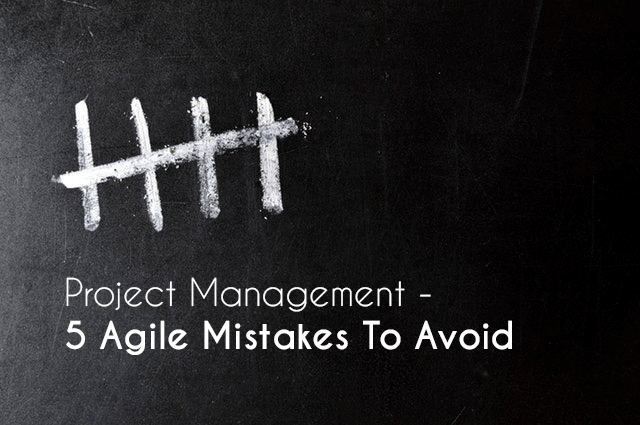As more and more teams adopt Agile practices to their projects, we can find ample information on how to achieve success. However, in reading such information certain things can get easily lost. And more often than not, those are the important things. That’s why, I felt that another kind of an Agile list was in order. Instead of focusing on how to do Agile, I want to talk about the worst mistakes you should avoid.
Reading the theory and practicing it are two different things. And when learning a new skill I often find it is better to know a couple of definite no-no’s, than a hundred things you should do. So before you is a short list of the worst Agile mistakes to avoid. Make sure you steer clear of those and I am sure your Agile transition will be a lot smoother.
1 Expecting a quick transformation
One of the worst and the most common mistakes that project managers make is thinking Agile transformation will be quick. Just reading the theory and familiarizing your team with it is really not enough in this case.
An Agile transformation takes not only knowledge of the rules, but a full on mindset change. Thus it takes time and dedication to make it work in the long run. If you truly want an Agile organization, be prepared to give it all you got. Most of the time it takes several separate stages, such as – understanding the practice, familiarizing the team with it, running the first project, adjusting to your needs, redefining processes, including your customers, etc.
It can take anywhere from a month to a year for your company to become Agile. But don’t worry as the process is just as important as the end result. And when you finally feel like you got the rhythm down, don’t forget to analyze the process from time to time to see if there could be any improvements. Agile is meant to be adaptive and thus it cannot be quick or definite at any point.
2 Keeping the previous structure
Another pitfall many managers seem to stumble upon is wanting to keep the structure as is. I know it may be hard to redefine teams, relocate resources and change the company structure, but if you want to be Agile you will have to.
It is important to understand that you are adopting a new way of doing things. And thus changing the way your teams are structured should not come as a surprise. Your teams now have to perform in a new way and this in most cases means that the structure you had is no longer suitable. There will be new requirements for the teams to fulfill and you will soon see frustration if they are not enabled to achieve them.
You will also need to rethink who will be in charge of those new teams. As previous project managers may no longer be suitable to perform the new scrum master roles. The two may seem like the same thing, but in reality they have very different responsibilities. Thus you will have to check if they can be performed by the same people. You can find more on their differences in this post.
3 Not adjusting your metrics
Undoubtedly you will want to measure the project progress and outcome. How else can you know if you have been successful? But if you are coming from traditional project management, the way you achieve it will have to change as well.
Agile works in iterations instead of the traditional phases. Meaning a lot of things are happening at once and you cannot really plan the project in the design-make-test pattern. However, i see many companies sticking to this approach when evaluating Agile project progress. Leading to miscommunication between the top management and the performing teams.
To avoid the struggle, you should understand that the Agile change happens not only on the performance level. It has to happen throughout the company, including the top management. Only when project monitoring and evaluation is fitted for the Agile practices, can you expect a harmonious environment.
4 Staying within a strict budget and timeline
Another thing a lot of traditional project management practitioners seem to struggle with is the budget and timeline. The problem? They want to know the numbers before the work even begins.
While you can still estimate both these metrics while working in an Agile manner it is important to remember that things should be allowed to change. That is not to say that you will have to extend timelines and budgets on a regular basis and you will most likely get pretty good at the estimations after a couple of iterations, but you have to accept that there is no such thing as a definite. In some cases you will have to compromise on time, money or the end result.
Instead of trying to control the project and make it fit into a certain timeline and amount of money, you should be focused on delivering the most valuable product you can produce in those constraints. Focus on what the product absolutely needs to be and leave the nice-to-haves for when you have extra time on your hands.
5 Not including your customer
Lastly, make sure to include your customer into the process all the way. Many Agile implementations fail, because the teams do not understand the importance of the customer participation in the process. Which leads to not presenting the most valuable product and thus completely diminishes the value of Agile.
Instead of only consulting your customer at the beginning and the end of the project, you should make them a part of your process. While it may seem burdensome to present results and consult with your clients after every iteration, you should understand that it is a key part of any Agile project. Only in this way you will be able to check and adjust your course of action and make sure to deliver the most valuable result in the shortest time.
Think about it, if your clients change their mind about something, would you rather know now or when the job is finished?
Agile is meant to help you and your team increase productivity and produce a better end result. Staying clear of these 5 Agile mistakes is sure to get you on the right track in achieving that.
Have your own Agile faux-pas? Share in the comments below!







